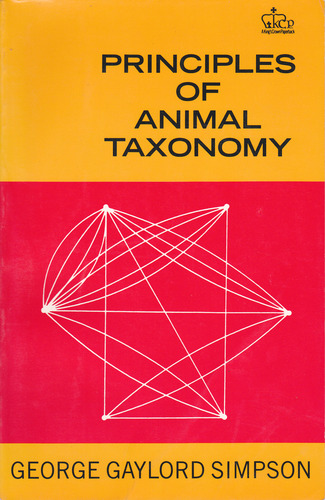Principles of animal taxonomy book
Par roy joseph le dimanche, septembre 18 2016, 05:28 - Lien permanent
Principles of animal taxonomy. George Gaylord Simpson

Principles.of.animal.taxonomy.pdf
ISBN: 023109650X,9780231096508 | 131 pages | 4 Mb

Principles of animal taxonomy George Gaylord Simpson
Publisher: Columbia University Press
French, German, Russian, and other languages do not have to accord with English ways of splitting up animals. The system that we still use today for giving scientific names to plants and animals has many founders, from the Greek philosopher Aristotle to the Swedish physician and botanist Carolus Linnaeus. Plant, animal and mineral systematics principles were stated by Karl Linney back in the 18th century. Hunn [13] Our objective, in this study, is to record the fishers' knowledge in relation to cetaceans, with special emphasis on folk taxonomy (ethnotaxonomy), analyzing fishers' forms of classification and nomenclature of whales and dolphins in the Southeastern Brazilian coast. The process of classifying and giving names to plants and animals was extensively studied by Berlin [3] who defines general principles to ethnobiological categorization and nomenclature. New York: Columbia University Press. English words do not need to be monophyletic. Biological systematics: principles and applications. Taxonomy is international -- everywhere, we recognize that humans are hominoids. Levels of structural organization; Outline classification of plants, animals and microorganisms; Principles and methods of Taxonomy. From microscopic investigation to the basics of veterinary medicine, Zoology covers principles of comparative animal anatomy, physiology, and genetics. While he continued throughout his lifetime to revise and expand this great work, so his successors have continued to revise the principles of taxonomy, now according to genetic principles, informed by the analysis of DNA. Biological Classification of Organisms. This course begins with an overview of key concepts in zoology as students examine the characteristics of the animal cell and discuss heredity and issues of evolution, including natural selection. We shouldn't smuggle taxonomic principles into everyday language to make a political argument. At all times, one of the key tasks of biology as a science was to establish the life form classification – systematics, taxonomy. Ithaca, NY: Cornell University Press. [that] are designed to enable zoologists to arrive at names for taxa that are correct under particular taxonomic circumstances. They then turn to taxonomy, as they study increasingly complex types of animals.